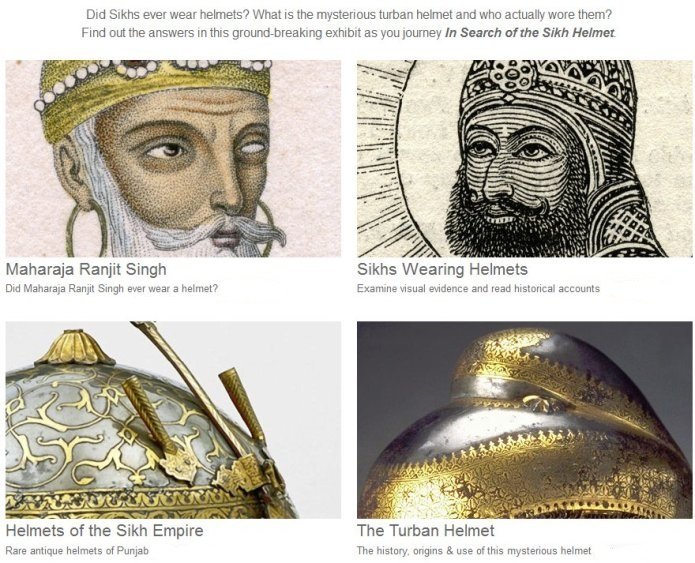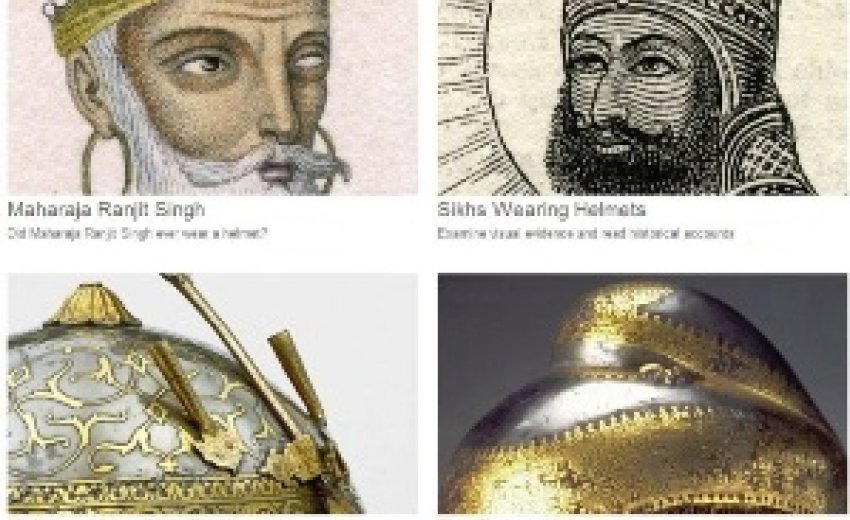|
Did Sikhs ever wear helmets in their history? Simple question, complex answer. It all started back in 1999 when the ground-breaking exhibit by the Victoria and Albert Museum, The Arts of the Sikh Kingdoms, published its book on the exhibit. In the book was a photograph of a decorative turban-shaped helmet with a top-knot dome and chain mail camail. Most contemporary Sikhs had never seen anything like this before. The caption mentioned that the helmet was from Lahore, the capital of the Sikh Empire. How could this be? Did Sikhs really wear helmets any time in their history? We all remember that famous modern painting of Banda Singh Bahadar, the one that shows him with that fierce scowl, his hand leaning on a large sword, and with a helmet on his head. Today there are popular paintings by contemporary artists featuring heroes from Sikh history depicted wearing turban helmet. Although many are familiar with these modern paintings or have seen an exhibit or book featuring the turban helmet, relatively little is known about the history of Sikh helmets as there has never been any major sturdy of the topic. The new SikhMuseum.com exhibit, ‘In Search of the Sikh Helmet’, seeks to rectify that deficiency. Over three and a half years of research has gone into preparing this ground-breaking exhibit. It is the first detailed study of its kind on the topic of Sikh helmets. The exhibit, ‘In Search of the Sikh Helmet’ endeavours to examine and answer a number of key questions: 1 Did Maharaja Ranjit Singh ever wear a helmet? One of the hot topics of contention has long been the whole notion of Sikhs wearing helmets in the first place. At the advent of World War I, the British had tried to persuade Sikhs to wear steel helmets instead of their turbans due to the fierce trench warfare in France and Belgium as Sikhs fought the deadly Germans and their allies. The Sikhs had adamantly refused to wear the helmets and the British had backed down – Sikhs went on to fight two World Wars proudly wearing their turbans. In modern militaries, turbaned Sikh soldiers have been forced at times to wear helmets and not given a choice. In these circumstances, such as parachuting out of an airplane or riding in an armoured vehicle, they have tied patka or keski (a small turban) and then worn the mandated military issue helmet on top. How did 19th century Sikhs of the time of the great Sikh Empire of Maharaja Ranjit Singh feel about the whole turban vs helmet issue? Research reveals that 19th century Sikhs seemed to have had an abhorrence to wearing caps or hats rather than turbans in military service as part of their religious beliefs. “Their uniform is after the French fashion, scarlet coaties, with green lapels, and worsted epaulets, black belts, tight breeches, and gaiters buttoned to the knee. The head-dress is a turban, as nothing could overcome the prejudice against a hat or cap.” [Asiatic Journal, 1839] “… [H]owever, the more closely-fitting dress of an officer belonging to one of the Maharajah's regiments pointed out that European customs had been adopted to some extent, but the existing head-dress of crimson or other bright coloured silk still attests the unwillingness of the Sikh soldier to wear the chako ..”. (William Barr, 1844) Although they had strong views against wearing military hats such as the shako (a tall, cylindrical military cap typically worn in British regiments), they seem to have felt differently about the wearing of helmets. A fascinating insight into the thinking of 19th century Sikh soldiers survives in the form of a letter between Henry Lawrence, the British Resident at Lahore, Agent to the Governor-General, and his correspondence with Lord Hardinge, the British Governor General of India. At the time Lawrence was trying to recruit Sikh soldiers in the British Indian Army following the first Anglo-Sikh War: “I have talked [he says in March 1846] to several men as to their entering our service. They at once said they would be delighted, and would go wherever we liked; but that they hoped we would allow them to wear their hair and turbans. The hair, I observed, would be respected, but turbans could not be allowed. After some talk they said there would be no objection to helmets or caps of iron. I thought that this would help us out of the difficulty, and I hope that your Excellency will approve of the idea, and authorize me to say that iron or steel caps will be permitted, and that their hair will not be interfered with ...The Sikhs say that, according to their holy books, any man who wears a cap will suffer purgatory for seven generations, and a Sikh would prefer death to having his beard cut.“ [Life of Sir Henry Lawrence, 1873] The Sikh soldiers that Lawrence encountered seemed to have differentiated between wearing a steel helmet and a hat, regarding the former as permissible, while the latter as unacceptable as per their 19th century interpretation of Sikh religious beliefs. It is important to note that this attitude towards wearing helmets was specific to that time period of the early to mid-19th century and was not carried over into military service in the post-Sikh Empire days of the British Raj. Following the 1849 annexation of Punjab and the integration of Sikh troops into the British Indian army, the Sikhs were allowed to wear their turbans and not required to wear helmets. To learn more about Sikhs and helmets, start your own journey of discovery by visiting the SikhMuseum.com website and viewing the exhibit, ‘In Search of the Sikh Helmet’. Please CLICK here to visit the Exhibit. [The author is the Curator of SikhMuseum.com and the creator of the world’s first Sikh website, Sikhs.org.] |
    |


